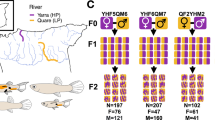Abstract
The relationship between fitness variation associated with a quantitative trait and a Mendelian factor affecting that trait was examined in a natural population of the South American grasshopperLeptysma argentina. Previous studies have shown that a centric fusion between chromosomes 3 and 6 (fusion 3/6) increases adult survival and body size in this grasshopper. Here we examined the possible relationships among fusion 3/6, a size-related trait (prothorax height) and adult survival in a natural population. The study was based on two generations, comparing samples taken at the beginning and at the end of the adult life span. All individuals were karyotyped and scored for prothorax height (PH). A nonparametric regression analysis revealed that adult survival monotonically increased with PH in both generations. Moreover, fusion 3/6 was found to have an additive effect on this trait. Within generations, fusion frequency increased with adult survival in males (but not significantly so), as expected if phenotypic selection on PH influences the fusion polymorphism. Using regression analyses, we show that the correlation between PH and adult survival is not a purely environmental correlation genetically independent from the fusion polymorphism. A simple model is proposed for testing similar hypotheses in studies of selection on a trait influenced by a known genetic polymorphism.
Similar content being viewed by others
References
Anderson W. W., Levine L., Olivera O., Powell J. R., de la Rosa M. E., Salceda B. M., Gazo M. I. and Guzman J. 1979 Evidence for selection by male mate success in natural populations ofDrosophila pseudoobscura.Proc. Natl. Acad. Sci. USA 76, 1519–1523.
Barbadilla A., Ruiz A, Santos M. and Fontdevila A. 1994 Mating pattern and fitness-component analysis associated with inversion polymorphism in a natural population ofDrosophila buzzatti.Evolution 48, 727–780.
Colombo P. C. 1989. Chromosome polymorphisms affecting recombination and exophenotypic traits inLeptysma argentina (Orthoptera).Heredity 62, 289–299.
Colombo P. C. 1993a Chromosome polymorphism and natural selection inLeptysma argentina (Orthoptera). I. Correlation with geographical, climatic and temporal variables.Evolución Biológica (ASIBE) 7, 21–39.
Colombo P. C. 1993b Chromosome polymorphism and natural selection inLeptysma argentina (Orthoptera). II. Gametic phase disequilibrium and differential adult male viability.Heredity 71, 295–299.
Colombo P. C. 1997 Exophenotypical effects of chromosomal change: the case ofLeptysma argentina (Orthoptera).Heredity 79, 631–637.
Endler J. A. 1986Natural selection in the wild Princeton University Press, Princeton.
Hewitt G. M. 1979Animal cytogenetics vol. 3Insecta 1: Orthoptera Borntraeger, Berlin and Stuttgart.
Joshi A. and Mueller L. D. 1993 Directional and stabilizing density-dependent natural selection for pupation height inDrosophila melanogaster.Evolution 47, 176–185.
Kirkpatrick M., Price T. and Arnold S. J. 1990 The Darwin-Fisher theory of sexual selection in monogamous birds.Evolution 44, 180–193.
Krimbas C. B. and Powell J. R. 1993 Introduction. InDrosophila inversion polymorphism (ed. C. B. Krimbas and J. R. Powell), pp. 1–52. CRC Press. Boca Raton.
Lee H. J. and Loher W. 1996 Influence of age and environmental factors on burrow-making behavior of the short-tailed cricket,Anurogryllus muticus (De Geer) (Orthoptera: Gryllidae).J. Insect Behav. 9, 819–834.
Norry F. M., Vilardi J. C., Fanara J. J., Hasson E. and Rodriguez C. 1995 An adaptive chromosomal polymorphism affecting size-related traits, and longevity selection in a natural population ofDrosophila buzzatii.Genetica 96, 2285–2291.
Price T., Kirkpatrick M. and Arnold S. J. 1988 Directional selection and evolution of breeding date in birds.Science 240, 798–799.
Rausher M. D. 1992 The measurement of selection on quantitative traits: biases due to environmental covariances between traits and fitness.Evolution 46, 616–626.
Ruiz A., Santos M., Barbadilla A., Quesada-Diaz J. E., Hasson E. and Fontdevila A. 1991 Genetic variance for body size in a natural population ofDrosophila buzzatii.Genetics 128, 739–750.
Schluter D. 1988 Estimating the form of natural selection on a quantitative trait.Evolution 42, 849–861.
Schluter D. and Nychka D. 1994 Exploring fitness surfaces.Am. Nat. 143, 597–616.
Sokal R. R. and Rohlf F. J. 1981Biometry (2nd edn). Freeman, New York.
Van Tienderen P. H. and De Jong G. 1994 A general model of the relation between phenotypic selection and genetic response.J. Evol. Biol. 7, 1–12.
Author information
Authors and Affiliations
Corresponding author
Rights and permissions
About this article
Cite this article
Norry, F.M., Colombo, P.C. Chromosome polymorphisms and natural selection inLeptysma argentina (Orthoptera): external phenotype affected by a centric fusion predicts adult survival. J Genet 78, 57–62 (1999). https://doi.org/10.1007/BF02994704
Received:
Revised:
Issue Date:
DOI: https://doi.org/10.1007/BF02994704




